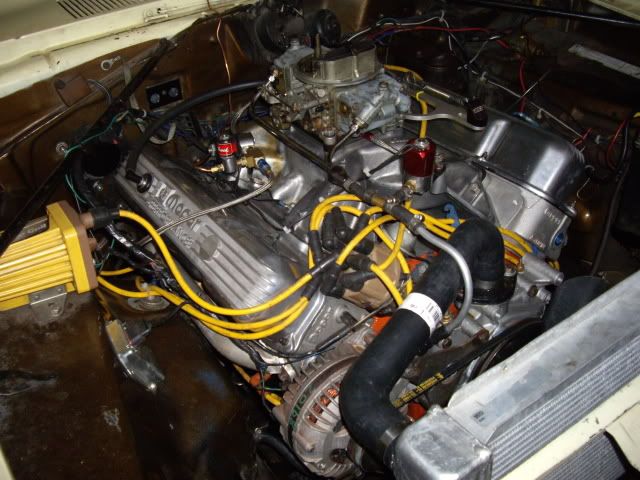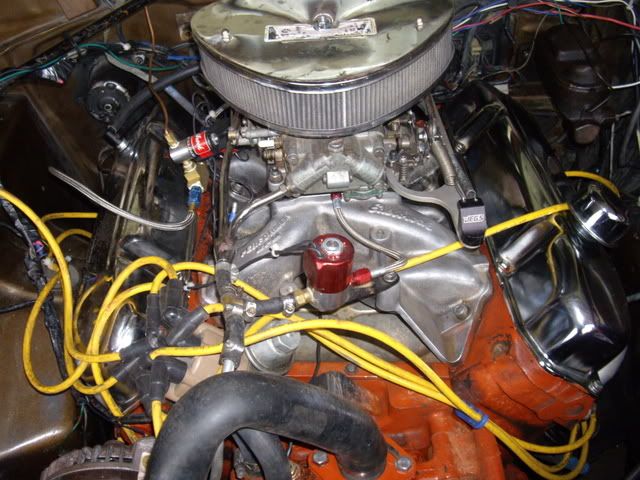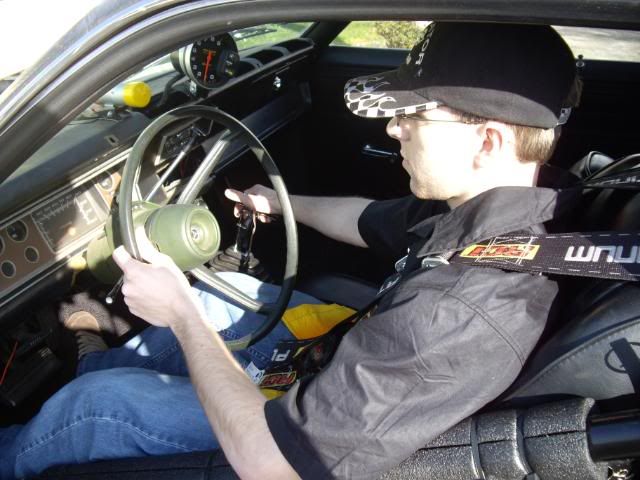The dimensions of the once-crappy 400 seem to be nearly ideal for performance builds these days.
http://www.arengineering.com/articles/ttstroker.html
Low Buck, Low Deck Mopar Stroker
By Andy Finkbeiner
Photos by Ron Valera
When the 426W in my 1965 Coronet spun a rod bearing, I decided to start looking into building a stroker motor for it. A little bit of research on the web at the Moparts.com site fueled the desire to build a motor based on a Chrysler 400 block with a 440 crank stuffed into it.
Putting a 440 crank into a 400 block typically yields 451 cubic inches, but I decided to have the rod journals offset ground for some extra stroke. Once I started to shop for parts I received some very pleasant surprises in terms of part combinations and prices. Since this combination is coming together so nicely for me I thought I’d share it with others.
The 400 block makes a great foundation for a serious street motor. Available from 1972 through 1978 in Chrysler’s bigger cars, it developed a reputation as a dog of a motor due to the low compression and lean burn system. None of that matters to me though since I’ll be dropping in some JE pistons and building it right. Not too many people know this, but a Chrysler 400 block is taller than the Chevy big block so there is plenty of space in there for the 440 crank and some long rods. After a little bit of searching, I found a 1972 400 shortblock for sale in the local paper for $50 so the first step was out of the way.
Before starting any machine work, the block was sonic tested. This operation should be considered mandatory whenever you’re planning to make more than 500 hp. Sonic checking will quickly tell you if the cylinder walls are uniform enough to take the load. Old wives tales about "thin wall" or "thick wall" blocks are not to be trusted. Any block from any year can be either thick or thin. Spend the $75 and be positive of what you have before you sink the remaining $4000 into it.
Here is the 1972 400 block getting decked. This was a nice thick casting so it should be plenty stout. Block was bored and honed with a torque plate to a finished diameter of 4.375 which is a popular Chevy size. The 400 block comes from the factory at 4.342 so a 0.033 over bore was required.
The crankshaft from the 426W had a spun rod bearing and the mains were 0.030 under so it was in sad shape. Typically these kinds of conditions would doom it to the junk pile, but for me it was perfect. The mains needed to be turned down from the 426 size of 2.750 to the 400 size of 2.625 anyway, so that cleans up that problem. The rod journals were too far gone to redo at the standard Chrysler size of 2.375, but there was plenty of meat to clean up at Chevy big block size of 2.200. In fact, there was so much meat that the machine shop offset ground the rod journals to a final stroke of 3.875. This was accomplished by grinding more off the inside of the rod journal than the outside. For a grand total of $250, I now had a std/std stroker crank!
I know it is starting to sound like a Frankenstein motor with the Chevy rod journals and the 440 crank, but the key to making this all work is a fantastic work of art from Manley Performance. Manley sells a connecting rod that is the Chrysler length of 6.765 inches, and is proper Chrysler width, but it uses the Chevy big block pin sizes of 2.200 and 0.990. This rod is a very nice design and is rated for 750 horsepower. Best thing was that when I went to buy these rods, Manley had them on sale for $495 on their website.
The crank started its life as a 426W crank in 1965. After several rebuilds and a spun bearing or two, it was ready for the scrap heap. By turning the mains down 0.125 and offset grinding the rod journals to 2.200, we had a stroker crank. Manley rods and JE pistons finish off the rotating assembly.
Final part of the puzzle for this stroker shortblock were the pistons. It turns out that this combination is becoming popular enough that several companies sell a stock piston right off the shelf. Muscle Motors sells their version of the Ross piston for $499 which is a tough price to beat. I went with the JE pistons on the advice of an engine builder friend, but I’m sure that any of the major brands will work just fine in this combination. I had the block bored and honed to a final bore size of 4.375 since that allowed me to use a popular ring combination. This is an overbore of 0.033 for the 400 motor so plenty of cylinder wall thickness was left for future rebuilds. Pistons are flat tops with valve reliefs and were set at 0.008 down in the hole.
What are these Chevy parts doing in a Mopar engine buildup? Chevy 4.375 rings, Chevy 0.990 piston pin and Chevy 2.200 rod bearings are what I used to make this Mopar stroker motor.
Manley Sportsman rods are Chrysler length and width, but have Chevy 2.200 rod journals and Chevy 0.990 piston pins. JE pistons are almost a pound lighter each than the stock Mopar pistons!
One minor complication was the fact that the crankshaft didn’t rotate in the block on the first try! It turns out that the 440 counterweight design is a little bigger than the 400 block was designed for. Some grinding on the block would have cleaned up the issue fairly quickly, but we needed to lighten up the crank anyway in order to balance the motor, so I turned the counterweights down in a lathe. A little bit of experimentation showed that if the counterweights were turned down to a finished diameter of 7.250 inches, the bobweight of the crank would be 2400 grams. Since the grand total of the rods, pistons, rings, and other parts was 2371 grams, we were in business. Final balancing was done by the engine builder and required only a tiny bit of material being removed from the crankshaft. Now the crank spun freely in the block and the final rotating assembly bobweight was low enough that this motor will think it is a small block!
The shortblock was buttoned up with a timing chain cover from Hershberger Motors. It is a part that looks cool and works well even though it was overkill for this application. This billet timing chain cover is designed for guys running roller cam motors since it allows them to precisely set the endplay of the cam. I’ll be running a solid lifter cam from Mopar Performance so I didn’t need this cover, but I liked the way it looked and I had saved enough money on the rods and cranks to splurge a little.
The oiling system is a combination of a Milodon dual inlet pump with a custom built full length pan. The hole in the pan is for the tie rod to run through since this motor is going into a stock chassis B body.
The Edelbrock heads were topped off with stainless steel rocker arms from Rocker Arm Specialist. These rocker arms are designed for the high performance street driven car and feature proper oiling holes and bronze bushings for long life. The tall M1 manifold, 750 cfm Holley carb and 1 inch spacer can also be seen in this picture. The adjustable throttle linkage comes from Mancini racing. Camshaft is the Mopar Performance 0.528 lift solid cam. With these 1.60 rockers, final valve lift is about 0.560.
Edelbrock aluminum heads were chosen because they flow so well for such a low price. These 84 cc heads work perfectly with the flat top JE pistons to provide a compression ratio of 10.5:1 which should be just about right for a street driven car. We were able to take them right out of the box and bolt them on. Sad to say, our experience with previous aftermarket big block heads had not been quite as pretty. One set of heads from a different vendor required several hundred dollars of re-work before we could even run them. In contrast to that experience, Edelbrock seems to be making a very high quality part with these heads. These heads were purchased from Greg at Magnum Automotive in Southhold, NY. Greg, or GregZ as he is known on the Moparts.com board was one of the first retailers to carry this head so we got one of the very first sets available.
Here we are on our date with the dyno! Final result was 550 hp at 5700 rpm. The cast iron manifolds kept the power curve from going up past that point, but the engine still made plenty of power for our chassis. Our goal was 500 hp so we were all pretty happy. The Edelbrock heads picked up almost 100 hp over a similar motor with a set of home ported 906 heads that we tested a few days later. Those back-to-back tests convinced us of the power capability of the Edelbrocks. Dyno testing as well as all engine machining was done at Gray’s Automotive in Tigard, OR.
Here is the home for the stroker motor. Notice how that the K member has been notched and boxed for oil pan clearance. This photo also shows some of the welding that is going on to reinforce the unibody in anticipation of that big block torque!
So that is the tale of the low buck, low deck stroker motor. Final size of the motor will be 466 cubic inches since we used the 3.875 stroke. Had the rod journals not been so wasted, I could’ve stretched it out to over 470 inches, but I had to work with what I had on hand. By purchasing a few parts on sale, and resurrecting a few others from the junk heap, the short block cost was kept fairly low. The MP cam is a very economical choice and the Edelbrock heads do not cost much more than a full rebuild on a set of factory cast iron heads. All in all, a motor like this can be duplicated for about $4000 if you do some careful shopping.
Contact Information:
Edelbrock
www.edelbrock.com
Gray’s Automotive
8975 SW Burnham
Tigard, OR 97223
503-620-4353
Hershberger Motors
PO Box 586
Woodburn, OR 97071
1-800-311-3945
Magnum Auto Repair
PO Box 1909
Southhold, NY 11971
Mancini Racing
PO Box 239
Roseville, MI 48066
1-800-843-2821
www.manciniracing.com
Rocker Arm Specialist
19841 Hirsch Court
Anderson, CA 96007
503-378-1075
www.shastacounty.com/rockerarm



















